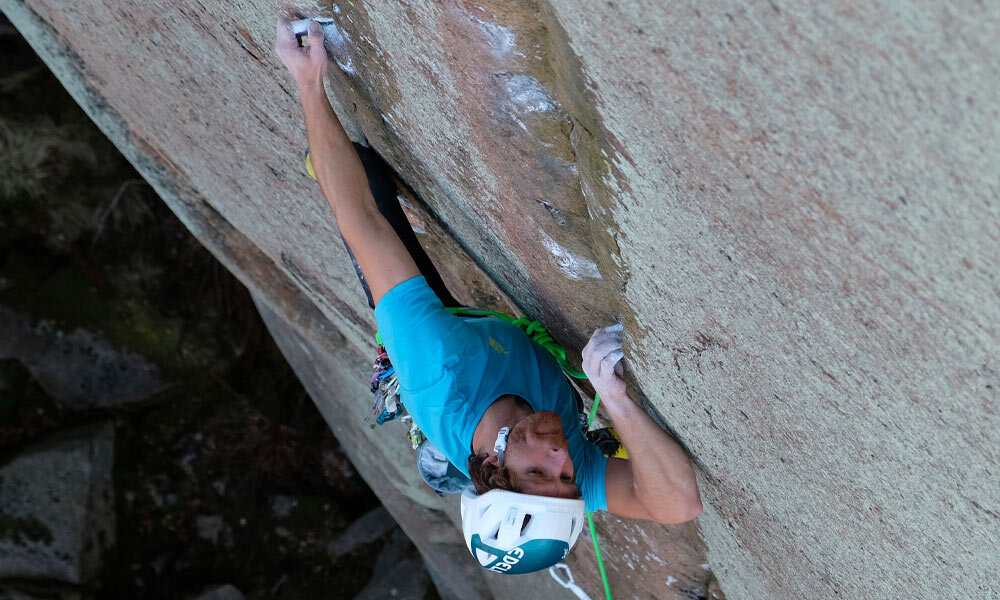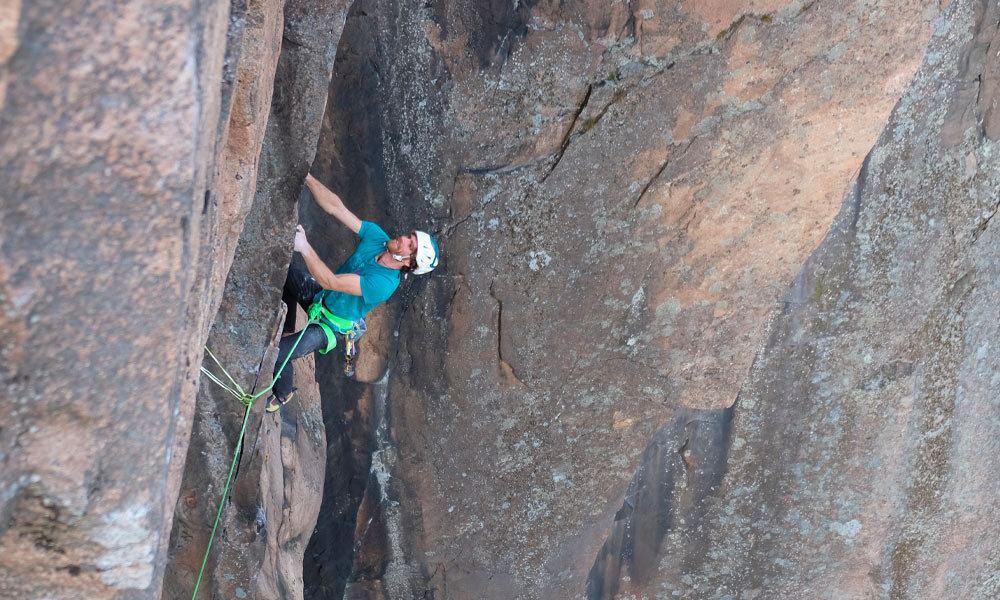“Friends of Bohuslän”
The night I arrived I watched the movie “Crackoholic” (2005). This is the movie everyone watches before making a trip to Bohuslän, a granite tradclimbing area on the Westcoast of Sweden. Despite the high quality granite, Bohuslän isn’t very well known in central Europe. Only 1h from Göteburg and 2h from Oslo, the coastline is covered in small hills covered with granite walls with a height up to maximum 60m. Bohuslän has a strong “clean climbing” ethic comparable with UK’s historical Gritstone ethics. No bolts and no anchors is what it takes to keep the walls clean and offer everyone the same climbing adventure the rock has to offer since the first ascensionist. While watching Crackoholic, I tried to take in the local climbing vibes. I also made a list of iconic routes of the area shown in the movie. Every one of these routes stands for an era and milestone in Bohuslän’s climbing history. To understand the local climbing culture, I had to climb them.
On the first morning I took out my list of routes and started off at the main sector, Häller. Overwhelmed by the rock quality and all the classic lines in this sector, I made the choice to go for the one that caught my eye the most, Savage Horse 9 R/X (8a). A piece of history, given that Leo Holding and Neil Gresham came to Bohuslän in 1999 and brought their British ethics with them. Leo climbed this line in style, placing a skyhook for protecting the crux high above the ground. Unlike his proud ascent, my ascent was a lot less scary. This is what you get when you climb 24 years later with improved gear to protect sketchy climbs. Instead of using a skyhook, which increases the danger of the route, I used a few RP’s for protection that were high enough to make sure you won’t hit the ground if you fell from the top. This gear beta came from Kristoffer Klevern, Oslo based tradclimbing maniac, who I was lucky to bump into. The route was brushed, a toprope installed and I had just to try! This is what I love about the single pitch trad climbs; it easily brings climbers together, sharing beta, gear and belays. After sending the route onsight on toprope, I checked the gear and went straight for the headpoint managing to send. It was only afterwards I heard this probably was the 4th ascent. I was excited, but I felt I didn’t give the route enough chance to kick my ass and learn from it, because a fall would be perfectly fine if the gear was placed well.
My first day was a success! I knew that from then on I would like to try the fairly safe routes ground-up without rehearsing the moves on toprope, because if I’m honest, the technical grade is below my limit and it feels far more rewarding to just try onsight or flash. There can be so much adventure in one single climb of 20 meters as long as you adapt it to your level. In the following days I tried “Rätt Lätt” 8+ R (7c+), “Sista Bossen” 9- (8a) and “Electric Avenue” 9- (8a) ground up. Like expected, the challenge was a lot more intense! “Rätt Lätt” is the only one I managed to flash, whilst the other two provided a great fight and some good falls. Especially “Electric Avenue”, the perfect crack that originally was protected with bolts up to the point that Erik Heyman climbed the line fully clean on trad gear. The rule of Bohuslän tradclimbing says that when a bolted line is climbed clean, it is accepted that the bolts will be removed. An ethical rule I support if the sector is generally a tradclimbing area.
Going ground up, onsight, and placing all my own gear on “Electric Avenue” was exciting! It’s not easy gear to place, and above all, the gear is very marginal at some points. I for sure could feel that extra ‘ground-up’ power when fighting above my gear. Oh yes, unlike people think I don’t experience fear of falling, I still do! I think I always will. It’s just key to use that fear in a positive way when sending by focusing on the move in front of you.
It can be hard to choose the perfect line for a ground up ascent at your level. I often arrive at the crag and scout out the lines, walking below them and trying to observe and feel. At first when I see a climb, I feel very intimidated. Even more when trying to imagine myself climbing it ground up - I get all these butterflies in my stomach and I better have a toilet nearby. Choosing the right route is not only about the moves, you will also have to assess the risks you might take or not. Once on the route, you’ll have to assess your current strength, the protection, the rock quality and your ability to do the move in the most efficient way. Will you commit to make the move, up to the next possible gear placement? Do you back up your previous placement? Does the fall look good? Is this a rational or irrational fear I’m feeling? If climbing onsight sport routes is one of the purest forms of climbing, then climbing trad routes onsight is even more pure! To me, this style is the most rewarding, success or not. Nonetheless, it doesn’t mean I’m shy of trying a project, a whole different game that has a lot to offer as well. This brings me to “Swedenborgska Rummet”.
“Swedenborgska Rummet” 9 R/X (8b) is a vertical and technical, short endurance route. I chose this line because of the technical nature and the big runout. Climbs with little protection attract me. Not because I’m an adrenaline junky, but mostly because climbing single pitch trad gets me in the ‘flow’ easier. The physical danger obliges me to be focused and concentrate in the moment. Getting into a state of flow is optimal to leverage your performance, which in climbing means to not fall! Hard onsights in sport climbing or a hard redpoint also brings me in a state of flow, but it’s more difficult.
I checked out “Swedenborgska Rummet” on toprope and I managed to send it quite quick in this style. But unlike on “Savage Horse”, the moves didn’t feel as solid. Body positions are subtle and delicate, sometimes I would fall not knowing what I did different? On a good day with only two taped fingertips because of splits, I decided I should give it a ground up go. I often make this choice quite rapidly. I don’t like postponing a ground up try for too long, otherwise it gets into your head too much. I climbed the route once more on toprope and didn’t waste any more precious skin. I felt positive about this try as the gear was good after the crux move, which makes the route a lot less run out than when the first ascensionist, Erik Grandelius, climbed it. I climbed solidly and moved my way up on the sharp razorblades, splitting two more fingertips. At that moment I knew I had to send, I wouldn’t have a second chance. I stayed calm and climbed secure - it wasn’t as runout as I thought but still, I wasn’t keen to test the gear with a fall!
Every once in a while I need my dose of single pitch tradclimbing; the exciting ground up onsight attempts, the challenge of placing gear, the harder headpoints after having worked the moves on toprope, the support of the community you get when attempting a scary climb… These are all beautiful challenges and experiences you can only find in a single pitch trad area. Bohuslan is one more special place I added to the list of; ‘I have to return’.





